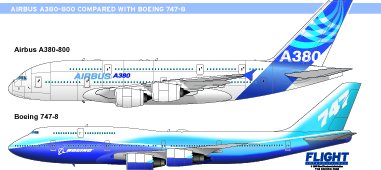Boeing’s decision finally to launch its first major 747 derivatives in nearly 20 years sets the scene for a battle at the high-value top end of the commercial airliner market and throws down the gauntlet to arch-rival Airbus to deliver on its promise that the all-new A380 will dominate the sector.

The US manufacturer expects the arrival of its stretched updated passenger and freighter 747 models to constrain sales of the 555-seat A380 to fewer than 500 over the next two decades. This would be achieved by taking more than half of what Boeing projects will be a 900-unit market for aircraft able to accommodate more than 400 passengers in three classes, of which around 40% will be freighters. Airbus has always insisted that it expected competition in this sector and, in contrast to Boeing, predicts a potential market of more than 1,600 aircraft over the next 20 years.
Spearheading Boeing’s attack on the A380 is the 747-8 Freighter, for which Cargolux Airlines will be launch operator, taking delivery of the first of 10 aircraft on firm order in September 2009. Japan’s Nippon Cargo Airlines has made a firm commitment to take eight. Including the options, the pair have signed for a total of up to 34 aircraft, worth $5 billion at list prices. The -8F will be 5.6m (18.3ft) longer than the -400F and provide 16% more cargo volume and a payload capacity of 140t.
The passenger version, stretched by only 3.6m and dubbed the “Intercontinental”, will follow but has yet to attract a launch operator, a situation that Boeing Commercial Airplanes president and chief executive Alan Mulally expects to be rectified “next year”. It will accommodate around 34 more passengers in a typical three-class layout and fly around 1,570km (850nm) further than today’s -400.
Mulally says the improvements being introduced to the 747 design – principally the use of state-of-the-art engines being developed to power the new-generation 787 and A350 twinjets – take “the performance of the 747 to the next level”. The manufacturer says the -8 designation was selected to “show the technology connection between the 787 and the new 747”.
Announcing the launch of the project in London last week, Mulally blamed the previous non-availability of such capable engines for the string of failed attempts to get a stretched 747 off the ground. The problem was that the airframe and aerodynamic changes that would have been needed to deliver the requisite performance improvements without the new powerplants could not be made economically viable, he said.
Designed to accommodate around 450 passengers in three classes, the 747-8 will provide about 20% more capacity than the 777-300 twinjet, but 20% less than the A380-800. “It’s right in the sweet spot of what we think the airlines will want,” says Mulally. He claims that the –8 will offer 8% lower seat-kilometre costs than the 747-400 and 6% lower than those of the A380, but with trip costs “25-30% less than the A380”, principally because the Boeing aircraft will weigh 13% less per seat.

Notes * Freighter Versions**main upper deck source:manufacturers
The freighter will boast “15% better” tonne-kilometre costs than the 747-400 and “23% better than the A380”, Mulally claims. “The primary market will be Europe and Asia because it’s just expanding so fast in freight,” he adds. The two 747-8 variants will be exclusively powered by General Electric GEnx turbofans.
Production of the 747-400, which currently has an order backlog of 47, will cease following the entry into service of the -8 in 2009. List price of the -8 Intercontinental is $250-265 million and the -8F $265-275 million, compared with $205-237 million and $210-236 million for the -400ER and -400ERF, respectively.
ANDREW DOYLE/LONDON
Source: Flight International
















